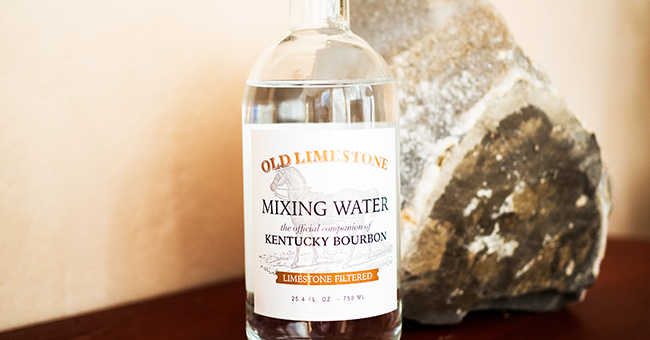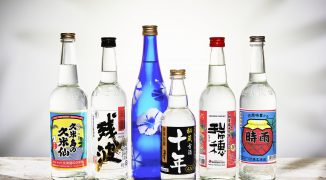Good whiskey starts with good water. Distillers — from Scotland to Kentucky to Japan — are obsessed with water, often speaking reverentially about the unique properties of the aquifers and springs that lend their spirits a signature character. But now that many distilleries are using municipal water, especially for proofing down spirits, does that mean the importance of water is the stuff of lore? If water really matters, is it ok to use tap water for the classic whiskey-and-water combo?
I set out to explore these questions first with a taste test (in the name of journalism). With the help of some die-hard whiskey fans, I sampled three bourbons (two from Kentucky, one from the Southwest) with four different types of water — Old Limestone, well-water with a high mineral content, tap water, and distilled water.
Old Limestone is bottled mixing water from Kentucky’s natural limestone-filtered aquifer, which Kentuckians credit for the state’s preeminence in both bourbon and strong race horses. Doug Keeney, the founder of Old Limestone, sees the mixing water as a way for drinkers to taste Kentucky bourbon “as the master distiller intended,” and to stay true to the concept of bourbon-and-branch, in which the spirit is mixed with the same waters that branch from the original source used in production.
It’s worth mentioning that whether you should add water to your whiskey at all is a matter of debate. Water reduces the ABV (or proof) of the dram, but the reduction of alcohol makes it easier to smell and taste the hundreds of sensory compounds that make whiskey taste like whiskey. (That’s why it’s customary during nosing sessions to dilute whiskey way down to 40 proof — it prevents burning your nose hairs off and olfactory fatigue.) These sensory compounds, called esters, fusel oils, and other congeners, are also released out of solution by the addition of water. With other spirits, you can literally see this happening — for example, in the louche effect of absinthe. Water transforms and shapes how we experience the original spirit, which brings us back to our taste test.
I was skeptical at first about the concept of Old Limestone, but it’s true that all water does not taste the same, and there’s a vast difference between chlorinated, metallic-tasting tap water and sweet spring water. Doug Keeney describes the effect of branch water as “unmasking nuances that the master distiller worked so hard to get into that bourbon” and perhaps analogous to reviving freeze-dried food — “it makes things blossom and it maintains the integrity of the original flavor profile.”
Our tasting group was pleasantly surprised that the addition of a splash of Old Limestone to Kentucky bourbons created a significant difference in aroma, taste, and mouthfeel. There was a remarkable improvement in a 9-year single barrel bourbon that originated from the bottle with strong solvent-y notes (acetone and acetaldehyde for my fellow whiskey geeks). After the addition of Old Limestone, the spirit smoothed out considerably with a “velvet middle,” and brought highlights of dried fruit, vanilla, and nutmeg to the fore — the spirit was transformed from harsh to complex and well-rounded. Distilled water had a limited effect on the same bourbon (dilution without sensory changes), the tap water concoction added notes of swimming pool and band-aids, and mineral-rich well-water brought out floral aromas but was notably more brittle in the mouth than the Old Limestone.
The group was divided over limestone water’s effect on a second Kentucky bourbon. Old Limestone brought spice and wood notes to the fore, while the well-water opened more floral notes. Interestingly, the Southwestern bourbon wasn’t markedly improved by limestone water. It came from the bottle with strong floral and butterscotch notes, which were accentuated by the well-water but somewhat muted by the limestone water. Tasting isn’t an exact science, and it came down to personal preference as to which water was superior for which spirit. Still, Old Limestone definitely created a noticeable rounding and flavor enhancing effect for all.
What explains the effect of limestone water on bourbon? Many Kentucky distillers point out that their water is uniquely soft, calcium-rich and iron-free. During the whiskey-making process, using water with low iron levels is important, because iron inhibits proper fermentation and can cause yeast to produce off-flavors. It’s commonly repeated that iron turns mash water black, and while I couldn’t find any scientific sources to support this statement, it is true that iron can react with the tannins in oak barrels and add an unfavorable dark pigment to aged spirits. When it comes to a splash of water added to a glass of whiskey, I can’t say for sure whether the presence of iron makes a difference. But the mineral profile and softness of Old Limestone could explain its “velvet middle” effect, as calcium-carbonate (e.g., limestone) is known to bind less favorable congeners, like sulphides.
Water’s wide range of qualities — such as hard vs. soft, mineral content, pH, and many other variables — does make a difference, even when it’s just a splash that’s added to your whiskey glass. Trade knowledge attests that water brings out the characteristics of its source. According to Rachel Barrie, master blender at Bowmore, soft water (like Speyside and Kentucky limestone water) is softening on the palate and can bring out fruit and honey notes. Acidic water (like the sources used by Islay distilleries) can bring out peaty and briney notes. And hard, mineral-rich water (which can be found in the Scotch Highlands and the U.S. Southwest) can release floral notes and impart “an intense and intriguing textural experience,” according to Barrie.
Ultimately, there may be no such thing as the “best” mixing water, since flavor is subjective. But matching mixing water with whiskey’s source water certainly allows the imbiber to experience the master distiller’s original vision. While it may not always be possible to get, for example, Highland water for your Scotch, certain brands of bottled mineral water might prove a good match, and avoiding tap water for your favorite whiskeys is a good rule of thumb.





